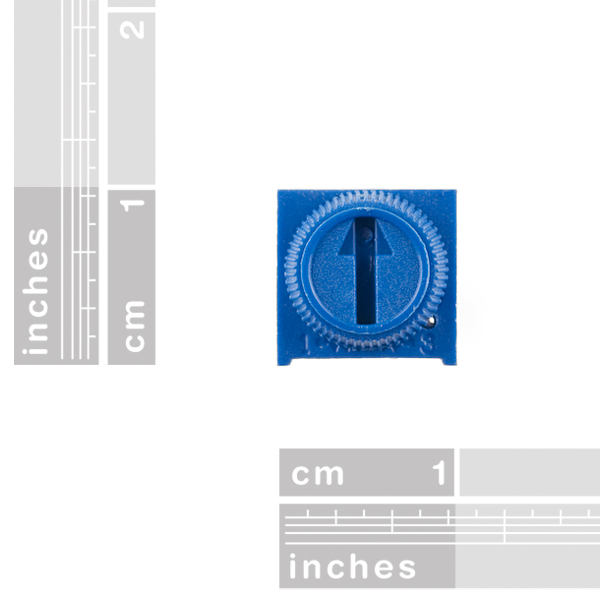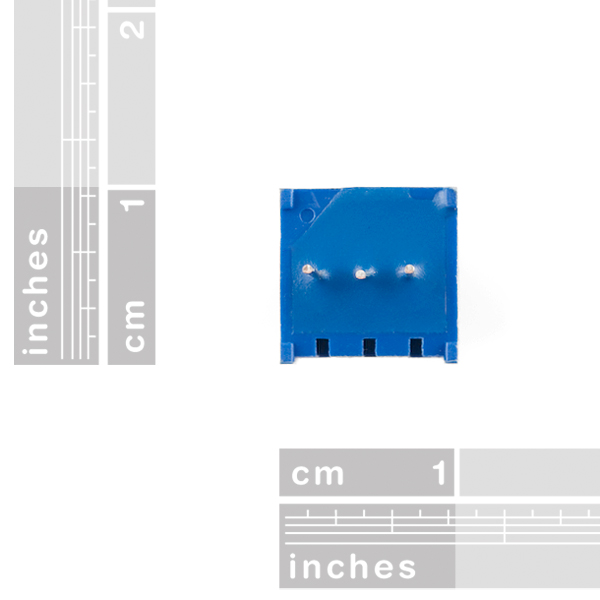There are lots of trimpots out there. Some are very large, some so small they require a screwdriver. Here at SparkFun, we just needed a simple one that worked. This 10K trimmable potentiometer has a small knob built right in and it's breadboard friendly to boot! Perfect for your next LCD contrast adjuster, opamp setting, or volume level. This model # is TSR-3386U within the datasheet.
- Datasheet (Note pins are in a single row, as shown in the pictures)
Trimpot 10K Ohm with Knob Product Help and Resources
Resistors
April 1, 2013
A tutorial on all things resistors. What is a resistor, how do they behave in parallel/series, decoding the resistor color codes, and resistor applications.
Experiment Guide for the Johnny-Five Inventor's Kit
June 28, 2016
Use the Tessel 2 and the Johnny Five Inventors kit to explore the world of JavaScript enabled hardware through 14 awesome experiments!
SparkFun Inventor's Kit Experiment Guide - v4.0
November 15, 2017
The SparkFun Inventor's Kit (SIK) Experiment Guide contains all of the information needed to build all five projects, encompassing 16 circuits, in the latest version of the kit, v4.0a.
Non-Addressable RGB LED Strip Hookup Guide
February 19, 2020
Add color to your projects with non-addressable LED strips! These are perfect if you want to control and power the entire strip with one color for your props, car, fish tank, room, wall, or perhaps under cabinet lighting in your home.
Python Programming Tutorial: Getting Started with the Raspberry Pi
June 27, 2018
This guide will show you how to write programs on your Raspberry Pi using Python to control hardware.
Beginner Parts Kit Identification Guide
March 22, 2019
The essential parts for beginning (or even experienced) hobbyists that gives you all of the basic through-hole components you will need to get started playing with embedded projects. We'll identify a few parts in the kit and provide a few basic circuits to get started!
SparkFun Inventor's Kit Experiment Guide - v4.1
August 8, 2019
The SparkFun Inventor's Kit (SIK) Experiment Guide contains all of the information needed to build all five projects, encompassing 16 circuits, in the latest version of the kit, v4.1.2 and v4.1.
Magnetic Levitation
November 20, 2019
This tutorial will show you how to build a magnetic levitation circuit using common parts.
Comments
Looking for answers to technical questions?
We welcome your comments and suggestions below. However, if you are looking for solutions to technical questions please see our Technical Assistance page.
Customer Reviews
4.8 out of 5
Based on 6 ratings:
1 of 1 found this helpful:
These are just the thing for breadboarding analog circuits!
For a contrast control for an LCD, time or duty cycle adjustment for a simple 555 circuit, or giving a quick analog value to a digitizer like the analog inputs on an Arduino, this is quick, compact, and easy to use. Just plug it in to your breadboard and twiddle to your heart's content, no tools needed. The knob is removable if you like.
1 of 1 found this helpful:
Great Pots
Nice size for the fairly fat fingered person.. turns smoothly and functions well.. Breadboard friendly.You have the option of hand turning or using a flathead screwdriver. Will buy again and again
1 of 1 found this helpful:
VERY MUCH GOOD SUCH TRIMPOT
Fantastic for bread boarding! Comes with a knob which i have yet to find elsewhere, great for me with my fat fingers and lack of computer sized screwdrivers! Be careful when you turn it, too fast and you will break the leads!!! But as long as you are delicate with this its great!
1 of 1 found this helpful:
Great LCD Brightness Control!
I just bought a pack of 10 to not only use for my projects (because I have the crappy screw adjustment POTS) but to control the brightness of my LCD display. The knob makes it so much easier to control.
Love that KNOB!
Excellent product, and within acceptable tolerances. Glad you sent the Review Inquiry. It reminds me I need four more!
So nice not to dig for a micro-screwdriver when I need to adjust this sucker!
Wipe it.
Handy small package works well and stays out of the way, unlike most of the pots I have had the fortune of using.





Bless you for getting a trimpot with a knob on it that is a short, manageable size. I'm sick of having to saw down the usual kinds!
It fits in a breadboard, but it's not quite "friendly". The friction of turning the knob is almost as much as the flex strength of the leads coming out the bottom. Turning the pot in a breadboard requires two hands to avoid damaging the leads. I haven't broken a lead off yet, but they got pretty bent up before I figured this out.
Still, can't beat the price for those infrequently-tweaked settings.
I was adjusting one of these last week and the knob came off, revealing a little slotted shaft. It goes back on easily, but revealed that this little trimpot can be used in close quarters, with a screwdriver, with or without the knob. The shaft can be set up to protrude through a hole, as well.
is there any round date that these will be back?
If anyone is interested I've made a tutorial on using these to control servos via an Arduino.
Tutorial
Can this pot be used as a replacement for a project where a 100K linear pot is specified?
Probably not, the range is only 1/10th of what's specified. It would be best to find a 100k linear. Check mouser or digikey, they have a LOT of options.
Love this little trimmer ... perfect for prototyping. Need different values!!! Looked on the datasheet but still confused about the actual part number. Is it TSR-3386U-103T or TSR-3386U-EY5-103T? I need it so I can find other values at other vendors.
It says this part is in the eagle library. What is it called in the library?
If it's "breadboard friendly" (meaning 0.1" pitch), wouldn't the EAGLE footprint be the same as the knobless 10K trimpot you've got?
Why was that dumb? Yes - the same footprint should work, we just haven't checked it so be wary.
The pin footprint is the same, but the case on this one is slightly larger than the aforementioned knobless one. I just checked on one of my designs which used your 10K, this one would not fit.
Scratch that. That was dumb.
The 200 cycles rating is typical for trimpots with knobs. Just buy a bunch of them if they're going to be used a lot, 'cause they will wear out. For a volume control, a more substantial panel mount potentiometer or encoder should be used.
This is a good price for this type of trimpot. It would be nice if other values (e.g. 5K, 20K, 50K, 100K) were made available too.
This is the kind of trim pot to throw in a tool box or a parts bin that can sit in there gathering dust until you build the prototype for your next "LCD contrast adjuster, opamp setting, or volume level" or whatever.
A panel mount pot or a shaft encoder is going to have a better life span, so use one of those in the final design. Or use this in a final design that might need occasional trimming.
But if you are building a proto for a filter or amp for your next radio or stereo or whatever, this pot will do the job. Or use it in a final design and make it easily replaceable. Use those engineering skillz.
or LEDs or even RGB LEDs in which this product can be used as a dimmer
Yep, you would not want to use this as a volume knob. It's probably not accurate enough and too noisy. Great for just a simple trimpot. (which it is!)
RobertC,
I wasn't criticizing its legitimacy as a trimpot, but the description above includes "Perfect for your next LCD contrast adjuster, opamp setting, or volume level.". As you agree that this component is not suitable as a volume control, perhaps you'd care to edit the description.
For the record, I did check the specs for a few potentiometers claimed to be suitable for volume control and the specs for a few trimpots before I wrote my original comment. I found 5-10k cycles as typical for the former and 200 as typical for the latter.
Eric
Umm, the datasheet appears to specify a "rotational life" of 200 cycles. Doesn't that make the part far better suited for trimming a circuit that's adjusted rarely than it is suited for such things as volume control?
Eric
It is not out of the question to create a prototype audio outputting circuit that does not require the user to adjust the volume. But, you are correct, this is probably not a part that you would use on a production device unless that device needs to be factory tuned.